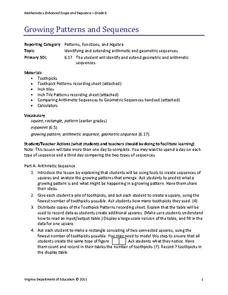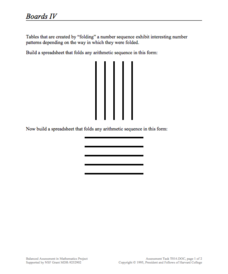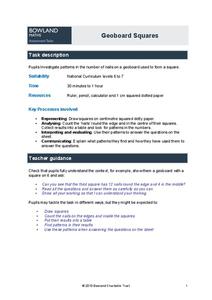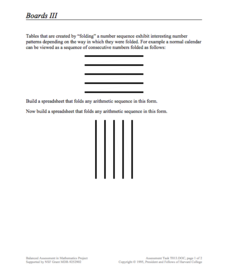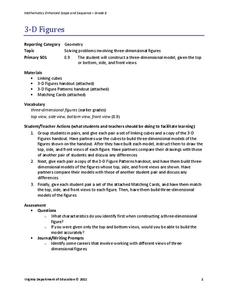Noyce Foundation
Tri-Triangles
Develop an understanding of algebraic sequences through an exploration of patterns. Five leveled problems target grade levels from elementary through high school. Each problem asks young mathematicians to recognize a geometric pattern....
Curated OER
Geometric Sequences and Series
In this algebra worksheet, students solve sequences using the geometric mean for sequences and series. They have to find the next number in the pattern using the formula for geometric means. There are 23 problems to be solved.
Virginia Department of Education
Growing Patterns and Sequences
Learners explore, discover, compare, and contrast arithmetic and geometric sequences in this collaborative, hands-on activity. They build and analyze growing patterns to distinguish which kind of sequence is represented by a set of data...
Concord Consortium
Boards IV
Build a connection between algebraic sequences and spreadsheets. Learners examine a specific folding pattern and convert the pattern into a spreadsheet. The goal of the spreadsheet is to produce a sequence of a specific pattern modeled...
Bowland
Geoboard Squares
Don't be a square! Help your budding mathematicians discover patterns within squares. Scholars create squares on geoboards and identify patterns in the number of nails, both nails on the edge of the squares and nails within the squares....
Concord Consortium
Boards III
Learn to visualize mathematical patterns as a folded pattern. Beginning with a visual display, the task encourages pupils to view sequences as a folded table. The pattern of the table then becomes a formula in a spreadsheet that...
Mathematics Assessment Project
Sidewalk Stones
One block, two blocks, white blocks, gray blocks. In the high school assessment task, learners investigate patterns of sidewalk stones to develop a quadratic expression for each colored block. Young mathematicians then use the expression...
Virginia Department of Education
3-D Figures
Scholars construct three-dimensional figures to study dimension and side views. Learners build models using linking cubes to match views of different sides. After practicing with models, they attempt to match three-dimensional drawings...
Mathematics Assessment Project
Table Tiling
How many total tiles does it take to tile a table top? Learners apply geometric concepts to determine the number of tiles needed for a specific square table top, and then use the result to create expressions for the number of tiles...
Curated OER
Complete the Patterns
In this patterns worksheet, learners analyze the geometric shapes in each of 5 rows. Students determine the pattern and then draw the next three shapes that would continue the sequence.
Curated OER
Complete the Patterns
In this patterns instructional activity, students analyze a row of geometric shapes in a pattern. Students draw the next three shapes that would come in the sequence. There are 5 problems.
Curated OER
Honors Algebra 2 Reivew: Practice with Sequences
In this practice with sequences worksheet, students find the arithmetic sequence and geometric sequence of given problems. They determine the percent of change and solve exponent problems. This one-page worksheet contains 11 problems.
Curated OER
Problem Solving Patterns
In this problem solving patterns worksheet, 6th graders solve and complete 2 various types of problems. First, they identify what the 4n represents in each block pattern illustrated. Then, students determine the number of arrows added to...
Los Angeles County Office of Education
Assessment for the California Mathematics Standards Grade 1
Here is an assessment designed to test mathematicians' knowledge of writing numbers, comparing numbers, skip counting, solving addition and subtraction problems; along with measuring objects, telling time, identifying shapes, reading...
Curated OER
Sequences and Series: Geometric Sequence
For this geometric sequence worksheet, students find the next two terms of a geometric sequence. They identify the nth term and complete a sequence statement. Next, they find the geometric means of a given sequence. This one-page...
Curated OER
Finite Geometric Series
For this geometric series worksheet, students find the nth term in a sequence. They evaluate a given geometric sequence and determine the number of terms in a geometric series. This two-page worksheet contains 26 problems. Answers are...
Curated OER
Finding the missing vales and the sums for Geometric Series
In this geometric sums worksheet, students find the indicated sum of eight geometric series, the missing values of ten series, and solves for twelve addition problems related to geometric series.
Curated OER
Problem of the Day #8: Geometric Series
In this geometric series worksheet, students examine the terms of a series and prove the sum of given terms. They give examples of geometric series. This one-page worksheet contains ten problems.
Curated OER
Problem-Solving Strategy: Find a Pattern: Problem Solving
In this math patterns worksheet, students use the understand, plan, solve, and look back problem solving strategy to help them find the patterns for the two problems.
Curated OER
Seven Sequences and Series Activities
In this sequences and series worksheet, students complete seven activities covering arithmetic sequences, geometric sequences, and series. Fully worked out examples, formulas, and explanations are included.
Charleston School District
Pythagorean Theorem and Converse
You've heard that it is true, but can you prove it? Scholars learn the Pythagorean Theorem through proof. After an overview of proofs of the theorem, learners apply it to prove triangles are right and to problem solve. This is the second...
Curated OER
Patterns
In this patterns worksheet, students examine five strips of geometric shapes and then decide which of two shapes at the end is the next one to follow each pattern.
Curated OER
Patterns
For this patterns worksheet, students examine five strips of geometric shapes and then decide which shape out of two shown at the end should follow at the end of each strip.
Curated OER
Patterns
In this patterns worksheet, students examine five strips of patterns and decide which of two shapes at the end should follow the pattern shown.




